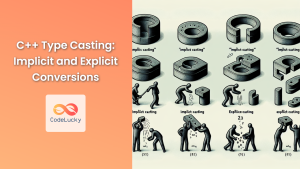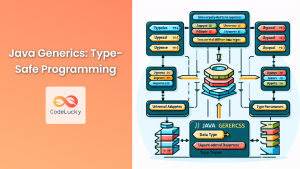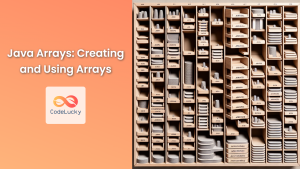Java, as a strongly-typed language, places great emphasis on data types. Understanding type casting is crucial for any Java developer, as it allows for the conversion of one data type to another. This article delves deep into the world of Java type casting, focusing on two primary forms: widening and narrowing conversions.
What is Type Casting in Java?
Type casting in Java is the process of converting a value from one data type to another. It's like pouring liquid from one container to another – sometimes it fits perfectly, and other times, you might lose some in the process.
🔍 Fun Fact: The term "cast" comes from the manufacturing process where molten metal is poured into a mold to create a specific shape.
There are two main types of casting in Java:
- Widening Casting (Implicit Casting)
- Narrowing Casting (Explicit Casting)
Let's explore each of these in detail.
Widening Casting (Implicit Casting)
Widening casting, also known as implicit casting, occurs when we convert a smaller data type to a larger data type. This process is automatic and doesn't require any explicit action from the programmer.
The order of widening conversions is:
byte → short → int → long → float → double
🔑 Key Point: Widening casting is always safe because there's no risk of data loss.
Examples of Widening Casting
Let's look at some practical examples:
// Example 1: int to long
int myInt = 100;
long myLong = myInt;
System.out.println("int value: " + myInt);
System.out.println("long value: " + myLong);
// Example 2: int to double
int anotherInt = 200;
double myDouble = anotherInt;
System.out.println("int value: " + anotherInt);
System.out.println("double value: " + myDouble);
// Example 3: char to int
char myChar = 'A';
int charInt = myChar;
System.out.println("char value: " + myChar);
System.out.println("int value: " + charInt);
Output:
int value: 100
long value: 100
int value: 200
double value: 200.0
char value: A
int value: 65
In these examples, we can see how Java automatically converts smaller data types to larger ones without any loss of information.
💡 Note: In the last example, the char 'A' is converted to its ASCII value 65.
Narrowing Casting (Explicit Casting)
Narrowing casting, or explicit casting, is the process of converting a larger data type to a smaller one. Unlike widening casting, this conversion is not automatic and requires explicit action from the programmer.
The order of narrowing conversions is the reverse of widening:
double → float → long → int → short → byte
⚠️ Warning: Narrowing casting can lead to loss of data if the value being cast is larger than what can be stored in the target type.
Syntax for Narrowing Casting
The syntax for narrowing casting is:
(target-type) value
Examples of Narrowing Casting
Let's explore some examples:
// Example 1: double to int
double myDouble = 9.78;
int myInt = (int) myDouble;
System.out.println("double value: " + myDouble);
System.out.println("int value: " + myInt);
// Example 2: long to int
long myLong = 9223372036854775807L;
int anotherInt = (int) myLong;
System.out.println("long value: " + myLong);
System.out.println("int value: " + anotherInt);
// Example 3: float to short
float myFloat = 3.14f;
short myShort = (short) myFloat;
System.out.println("float value: " + myFloat);
System.out.println("short value: " + myShort);
Output:
double value: 9.78
int value: 9
long value: 9223372036854775807
int value: -1
float value: 3.14
short value: 3
In these examples, we can observe the potential for data loss:
- The decimal part of the double is truncated when cast to int.
- The long value is too large for an int, resulting in a negative number due to overflow.
- The decimal part of the float is truncated when cast to short.
🔍 Fun Fact: The seemingly random -1 result in the second example is due to how Java represents negative numbers using two's complement.
Special Cases in Type Casting
Casting between char and int
As we saw earlier, a char can be implicitly cast to an int. The reverse is also possible but requires explicit casting:
int asciiValue = 65;
char character = (char) asciiValue;
System.out.println("ASCII value: " + asciiValue);
System.out.println("Character: " + character);
Output:
ASCII value: 65
Character: A
Casting with boolean
The boolean type is special in Java. It cannot be cast to or from any other primitive type.
boolean myBool = true;
// int myInt = (int) myBool; // This will cause a compile-time error
Casting with Strings
Strings are not primitive types in Java, so casting works differently with them. To convert between Strings and primitive types, we use parsing methods or the valueOf() method:
// String to int
String strNumber = "123";
int number = Integer.parseInt(strNumber);
System.out.println("Parsed int: " + number);
// int to String
int anotherNumber = 456;
String strAnotherNumber = String.valueOf(anotherNumber);
System.out.println("String from int: " + strAnotherNumber);
Output:
Parsed int: 123
String from int: 456
Best Practices and Pitfalls
When working with type casting in Java, keep these best practices in mind:
-
🎯 Use widening casting whenever possible: It's safer and doesn't require explicit syntax.
-
⚠️ Be cautious with narrowing casting: Always ensure that the target type can hold the value you're casting to avoid unexpected results.
-
🧪 Test your casts: When using narrowing casts, always test with edge cases to ensure your program behaves as expected.
-
📚 Understand the data: Know the range of values for each data type to avoid overflow or underflow issues.
-
🔍 Use appropriate types: Choose the right data type for your variables from the start to minimize the need for casting.
Common Pitfalls
-
Loss of Precision: When casting from floating-point types to integer types, the decimal portion is truncated, not rounded.
double pi = 3.14159; int roundedPi = (int) pi; System.out.println(roundedPi); // Outputs 3, not 4 -
Overflow: Casting a larger type to a smaller type can cause overflow if the value is too large.
long bigNumber = 1234567890123L; int smallerNumber = (int) bigNumber; System.out.println(smallerNumber); // Outputs -539222987 -
Unexpected Results with char: Remember that char is an unsigned 16-bit integer in Java.
char myChar = 65535; int myInt = (int) myChar; System.out.println(myInt); // Outputs 65535, not -1
Conclusion
Type casting in Java is a powerful tool that allows for flexibility in working with different data types. Widening casting provides a safe, automatic way to convert smaller types to larger ones, while narrowing casting offers more control but requires careful handling to avoid data loss.
By understanding the nuances of type casting, including the special cases and potential pitfalls, you can write more robust and efficient Java code. Remember to always consider the implications of your casts, especially when dealing with narrowing conversions, and test thoroughly to ensure your program behaves as expected.
Mastering type casting is an essential skill for any Java developer, enabling you to manipulate data effectively and write more versatile code. As you continue to work with Java, you'll find that a solid grasp of type casting will serve you well in a wide variety of programming scenarios.



















